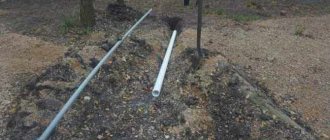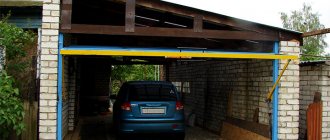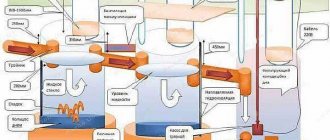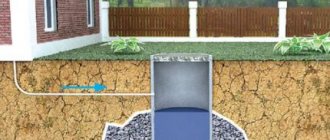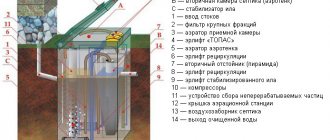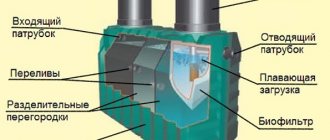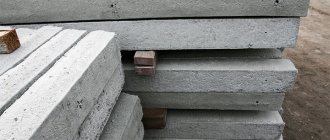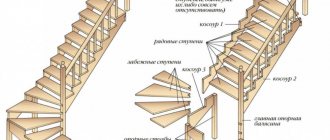Installation of concrete rings
For vertical installation of concrete rings in the ground, machine and manual methods are used; existing special equipment allows making round holes in the ground for any standard outer diameter of the well - for this purpose special drills or attachments in the form of horizontal knives are used. Homeowners who cannot afford to order special equipment often turn to the services of private craftsmen (shabashniks) who install concrete sewer wells manually.
When carrying out the work, two technologies are used: in the first case, they dig a deep hole and lower the rings into it, using a winch or holding them with their hands using ropes tied to mounting hooks. The second method consists of installing the ring on its workplace and digging out the earth from the inside, while as it deepens, the product falls down under its own weight.
In individual areas, concrete wells are usually placed after the septic tank, using them to drain (discharge) treated wastewater deep underground, therefore, before starting work, coarse-grained, fine-grained sand and crushed stone are purchased, which serve as a filter pad for the discharged wastewater. Typically, the sewage system made of reinforced concrete rings for drainage on the site has a low depth - to install it you will need two or three rings without a bottom; the top can be covered with a lid with a hatch.
Rice. 8 Support and additional reinforced concrete rings for sewerage – price list
Independent construction of a sewer well from concrete rings is carried out manually using the following technology:
- They dig a shaft of the required depth using one of the methods described above; they can be combined by digging a hole from the outside the height of one ring, and after installing it in place, then digging the ground from the inside - the element will begin to descend under its own weight. When carrying out work, be sure to monitor the vertical with a plumb line suspended from the outside or a building level. The depth of the drainage well is determined individually and depends on the labor intensity of the work carried out (the weight of the ring elements is important), financial resources, usually the number of concrete rings does not exceed three with a standard height of 890 mm, the diameter of the concrete ring is chosen 1000 or 1250 mm.
- To dig wells, it is more convenient to use products with a lock and metal ears, to which ropes are attached; after installing the first element, the ears are cut off and the next one is placed on it. When making a locking connection, no materials are placed between the rings; if the ends are flat, they are installed on a cement-sand mortar.
- After installing the concrete well, fine-grained, coarse-grained river sand (the thickness of the cushion is about 300 mm) and crushed stone (a layer of at least 400 mm) are poured onto the bottom, a hole is punched in the side wall with a perforator, an external sewer pipe is installed in it, the cracks are covered with cement mortar.
- The rings are buried under the sewer with manually raised earth, a round slab with a hatch is placed on top of the opening, which is closed with a light polymer lid.
Rice. 9 Installation of concrete rings for sewerage - main steps
Types of containers and features of their designs
Subject to the standard design of the device, design solutions may be different.
First of all, you need to understand that a septic tank is a source of increased danger to the environment and the uncontrolled construction of such facilities is prohibited. Before starting work, it is necessary to develop a project, approve it with the SES and only after that begin its construction. Permission can be obtained in full compliance with the requirements of San Pin and SNiP.
General rules for wastewater treatment facilities are as follows:
- The main document regulating the placement of sewage tanks in suburban areas is SNiP number 2.0403-85. It details the requirements for the location of the sewerage facility in relation to various buildings.
- If there are water supply facilities on the territory, the rules of relative location are provided for by SNiP 2.0401-85.
- Many distances according to the standards are provided for by the requirements of San Pin 2.1.5580-00.
- San Pin 2.2.1/2.1.1-12-03 establishes the rules for water protection zones of water supply facilities.
It should be taken into account that there are overlaps in the mass of regulatory documents. So in one of them the minimum distance from a shambo to a residential building is set at 10 meters, in others - 5. To avoid difficulties when approving a sewerage project, it is better to adhere to a larger norm.
Watch the video
➁SEPTIC TANK made from concrete rings WITH YOUR OWN HANDS ⓉⓊⓉⓈⓉⓇⓞⓘⓚⒶ
The design of a local treatment plant depends on many factors, ranging from the size and nature of the landscape to the qualitative composition of the soil. Therefore, there are several types of settling tanks.
Single chamber drives
It should be immediately noted that these structures are currently prohibited, although a considerable number of them still continue to be used. Let's remember the norms of water consumption - 200 liters per person. Even with two people living, this amounts to 0.4 cubic meters per day; even a five cubic meter storage tank is filled in at least two weeks.
5 cubic meters is the volume of a standard tank. That is, pumping must be done every 2 weeks, paying up to 12,000 rubles each time (for the Moscow region). Really? No! Therefore, most of the wastewater is poured onto the road, the garden, or anywhere. Only waste products go into the storage tank. And then we drink water from the well.
A sewer pit made of concrete rings slightly increases the period between pumpings, but calling such a structure a treatment device can only be a very stretch.
Double chamber
A sewer system made of concrete rings, consisting of two containers, provides greater opportunities for wastewater treatment. This happens for the following reasons:
- There is an additional opportunity for sedimentation of solid components of wastewater, settling to the bottom of the second vessel.
- In the second container, it is possible to treat with biologically active components that actively process contaminants in wastewater. For this purpose, cultures of anaerobic bacteria are used, which decompose the components of the drain and neutralize them. As a result, a dense bottom sediment is formed, which is called activated sludge. It is a habitat for bacteria, the content of which constantly increases, increasing the degree of purification. As it accumulates, it is necessary to periodically clean the tank with pumping out activated sludge, part of which is used to replenish the bacterial population.
Since we are talking about live cultures, chlorine is not allowed to enter the wastewater as it passes through the chamber. In this case, the death of the colony of beneficial bacteria is inevitable. If you want to carry out additional disinfection of purified water, it can be treated with bleach before discharging it onto the ground.
With this design of a two-chamber storage tank, concrete rings with a bottom for the first storage section are used as a container. The second section is installed in the form of a filter well.
It is a device of two rings installed on top of each other. In this case, the lower ring is used with perforation.
Let us pay attention to the design of the filter well. Its maximum depth is no more than 2.5 meters. Wherein:
- A gravel cushion 30 centimeters thick is formed at the bottom of the pit. The material used is a fraction of 5-15 millimeters.
- Before installation, the outer surface of the rings must be treated with a waterproofing material, for which bitumen mastic is most often used.
- The lower ring is installed on a gravel bed and wrapped in geotextile up to the perforation level.
- A bottom filter is formed using fine gravel or blast furnace slag, which has increased absorption. The layer thickness is 15-25 centimeters. On top of it you can fill the broken brick with the same layer.
- The same gravel is poured outside the ring to the perforation level.
- A second ring and a floor slab of the appropriate size, equipped with a passage hole, are installed. It is necessary to make a wooden lid for it.
- The top floor slab and neck are installed in a standard version with a metal or plastic cover.
- To avoid wastewater leaks around the formed well, you need to install a clay seal, proceeding as follows:
- the clay intended for it is poured into a cone and a funnel is made on top into which water is poured;
- soaking of the material is carried out within 6 days;
- the clay must be stirred to the consistency of sour cream, adding reinforcing shavings to the solution;
- Fill the funnel around the well with the resulting solution;
- Dry the resulting clay seal for about a month, periodically sprinkling it with water.
The hole for the overflow pipe from the first tank is punched before pouring the water seal, the joint is sealed with cement mortar and treated with bitumen mastic.
Watch the video
Three chamber devices
The difference between such sewerage devices made of concrete rings is the use of an additional container in which additional wastewater treatment occurs through aeration using a low-power compressor and an air spray.
Aeration of liquids is carried out in order to use another type of bacteria for their purification - anaerobic bacteria, which actively act in the presence of oxygen in the air. With their use, the degree of purification is increased to 98-99%.
This water cannot be drunk or used for cooking, but it can already be used for technical purposes - washing a car and even watering a garden. When passing through the ground, the water undergoes final filtration.
The water that has passed through the settling tank is disposed of in various ways:
- discharge into a sewer (drainage) ditch;
- discharge directly onto the ground;
- diversion to the nearest body of water.
Features and advantages of concrete rings
The advantages of reinforced concrete circles for the construction of treatment facilities appear when compared with other materials used for these purposes:
- Tanks made of red brick require waterproofing of internal and external walls. Even with careful work, they are short-lived and are destroyed by aggressive substances present in wastewater.
- The metal is susceptible to corrosion, especially in aerobic septic tanks under the influence of oxygen. The service life of containers made of black steel is short, and stainless steel is expensive.
- The main disadvantage of plastic is its light weight. Even when filled with water, it can be squeezed out when the soil heaves. Requires anchoring to a reinforced concrete slab. Eurocubes and plastic barrels have thin walls and require protection with a metal frame to prevent them from being crushed by the soil.
- Construction of a reinforced concrete monolith is a labor-intensive and long-term process.
Benefits of concrete
A septic tank for receiving household waste can be made of brick, polymer materials, stone, metal, concrete. The resulting structure is not overly loaded; its durability is affected by the resistance of the source material to aggressive substances and constant humidity. Constructing the walls of a sewer well from concrete rings is considered an ideal option for the following reasons:
- Concrete elements are used when constructing a septic tank on various soils; their resistance to compressive deformations allows them to withstand pressure from displacement of soil layers and groundwater.
- Availability of material.
- High speed of sewerage installation using concrete products.
- Sewerage made from concrete rings is durable and easy to maintain.
- Rings allow you to make a device of the desired depth and diameter.
- Resistance of the material to aggressive substances, groundwater composition and temperature changes.
- Easy to install yourself.
- A large selection of waterproofing materials to protect the walls of the future well.
- Thanks to metal reinforcement elements, concrete products are highly durable.
- Factory-produced products are designed for tight joining.
Concrete products are durable, but they also have their disadvantages.
The main disadvantages during operation: weight, certain difficulties with delivery and loading, the possible need to use lifting equipment and additional labor.
The area is sandy, the groundwater level is low, water is below 4 m or there is none
The combination of low groundwater level and well-draining soil are ideal conditions for constructing a septic tank made of reinforced concrete rings. Moreover, in this case, you can do without a filtration field, so the capabilities of a filter well are sufficient. There may be several design options; we have identified the simplest and most effective.
Scheme 4. 3-chamber septic tank with one hatch
Description:
- Compact 3-section septic tank with filter well.
- 1 hatch for servicing the entire system.
- Saving on additional rings - they are needed only for one well.
- Filter layer throughout the entire volume around the wells and between them.
- The bottom of 2 wells is concreted. There are no holes in the filter well, there are holes in the walls of the lower ring.
The following video shows the construction process without unnecessary comments. The main part of the work is carried out in 1 day. For increase
Conclusion:
This scheme saves space for installing external sewerage; there is no need to buy additional rings and hatches for 3 wells.
Scheme 5. 2-chamber septic tank with a filter well
Description:
- A simple diagram of a 2-chamber septic tank with a filter well.
- Can be installed and put into operation in 1 day.
- You can get by with wells made of two rings.
- The bottom of the first well is necessarily solid.
The simplified wastewater treatment scheme is due to the excellent drainage properties of the soil. In the video below, the author explains in detail the role of each structural element of the treatment plant. The video also contains a lot of food for thought, which will make you feel more confident when installing a septic tank.
Conclusion:
scheme for permanent or seasonal use. Takes up little space on the site, copes with volley discharges of wastewater. Large drainage layer resource. Pumping sludge from the first chamber no more than once a year.
Final work
Holes for pipes are punched in the designated places of the concrete rings. A house drain pipe is inserted into the first well. Then pipes connect all the chambers of the system. The joints are carefully sealed with mortar.
The next stage is waterproofing the joints of the rings, joints with pipes, and the outer (and preferably inner) surface of the concrete well.
Now each well is covered with a concrete cover, monolithic inspection hatches and ventilation pipes are installed. The work is completed by backfilling the soil into the remaining space of the pit, compacting the layers every 0.2-0.3 m.
The resulting sewage system made of concrete rings, whether built with your own hands or with the help of professional workers, will ensure the removal and high-quality treatment of household wastewater, protect the soil and groundwater on your personal plot from pollution, and eliminate the inconvenience of living in a private house. An inexpensive and effective treatment system will last at least 50 years.
Types of sewer rings and their scope of application
To drain sewer water, pipes are usually used that are made of polymer materials, cast iron, ceramics, asbestos cement, reinforced concrete; these products generally have a small diameter, with the exception of structures made of lightweight plastic components. If a large pipeline diameter is required for laying underground communications, the weight of long pipes becomes too large for transportation and installation of the line, so it is constructed from short rings.
Due to their low cost, wide sewer rings are made only from concrete, and this material currently has no competitors. With the development of modern technologies and the tendency to use polymers in all areas, analogs of concrete products have relatively recently appeared on the market - polymer-sand rings, which are used only for the construction of vertically installed structures.
If in the urban planning field, underground horizontal communications are laid from reinforced concrete rings for transporting organic waste, storm and gray wastewater, they are used as protection for water supply and gas pipelines, then in the household sector their use is of a different nature. In individual areas, reinforced concrete sewer rings serve as the main elements in the construction of the following structures:
Water intake wells. Installation of wells for collecting drinking water from reinforced concrete rings is one of the most popular methods of supplying water to individual residential buildings in urban and rural areas. The mine is dug manually or mechanized, after which sewer wall rings with a lock are immersed in it. If a well is made of concrete rings on the site, the depth of the structure can reach 30 m - in this case, a submersible electric pump is used to draw water.
Septic tanks. Some homeowners use sewer rings to build septic tanks or sedimentation tanks with their own hands, using structures with a closed bottom and top.
Drainage wells. Installation of reinforced concrete rings for sewerage in households is one of the most common areas of their application. Sewage water treated in individual septic tanks is disposed of on its own site, using aeration fields or drainage wells for additional purification and direction of wastewater underground. Many people install the drainage chamber with their own hands from reinforced concrete rings, installing several elements with a locking connection on top of each other in a vertical position.
Rice. 2 Engineering structures made of reinforced concrete rings
Inspection wells. Engineering structures of this type are needed for sewerage in a private house in cases where the underground pipeline has a large length or branches. To carry out cleaning, preventive work and inspection, small diameter wells are placed along the sewer pipeline. They are designed to provide access to inspection hatches installed in pipes for cleaning them in case of blockages and monitoring the condition of the line.
Caisson wells. A well made of reinforced concrete rings is often used to place pumping equipment in it, to protect a well source of water from freezing and precipitation when it is collected by a submersible electric pump or a surface pumping station. The depth of such structures usually does not exceed 2 m; during installation, they often use rings with a finished bottom or upper ceiling with a hole for a hatch; another installation option is the installation of separate round slabs for the bottom and upper manhole. Also, for caisson wells, experienced users purchase ready-made structures with built-in metal running brackets located along the entire height of the wall.
Septic tanks. Often in private households, especially in rural areas, residents who are deprived of access to a centralized sewerage system share waste disposal. They install a separate toilet for feces on the street, and gray water after washing dishes, laundry, cleaning rooms and other household needs is poured through sewer pipes into a drainage sump constructed from concrete rings.
Cellars. Concrete rings with a bottom can be used on a private plot for the construction of cellars intended for storing fruit and vegetable products deep underground in winter and summer.
Horizontal passages. When laying utilities under roads, to transfer water masses to the other side of highways and railways, large-diameter reinforced concrete rings are often used, which are simpler and easier to lay sequentially one after another than to immediately stretch a heavy long pipe.
Rice. 3 Excavation of soil for wells using special equipment
Where are concrete rings used?
- Manholes. Using reinforced concrete rings, concrete inspection wells are built, which are necessary for workers to service sewer lines.
Thanks to a wide selection of standard sizes, you can find rings of different diameters and different heights; they are easy to select based on the diameter of the pipe and the space needed to inspect it.
The inspection well is assembled quickly. A crane is used to move the rings. During installation work, reinforced concrete rings are firmly fastened together with a “lock” connection. The design turns out to be very reliable, and the influence of soil mobility on it is reduced to a minimum level.
The amount of groundwater depends on whether it is necessary to waterproof concrete sewer rings from the inside. It is made as a layer of polyethylene.
- Concrete septic tanks. With the help of reinforced concrete rings, cesspools are made for drains where it is not possible to connect to a centralized sewerage system. A septic tank made of reinforced concrete rings is quickly constructed on the territory of a private house.
For installation work, 2-4 people and a rented excavator are enough. If you equip your country sewer system with concrete rings, you don’t have to worry about the possible leakage of drains into groundwater.
Industrially produced covers for septic tanks with holes greatly simplify installation. And thanks to the grooved connection of the sewer rings to each other, subsequent sealing of the structure becomes easier.
Treatment stations made of concrete rings, as septic tanks are also called, are advantageous due to their modularity. You can assemble a manhole or a country septic tank from a set of installation elements, which includes:
- bottom of the structure;
- rings made of concrete in the required quantity of the actual diameter and height;
- cover with hole.
Concrete rings for sewerage
Precast concrete rings come in two different modifications. In the first case, there are annular projections at the top of the products. At the bottom of the rings you can see an annular recess. With its help, the reinforced concrete ring is attached to the adjacent one.
In the second case, there are no annular projections. During installation, the rings are secured using brackets and concrete mortar. When installing concrete rings under the sewer system in a private house, at a summer cottage, choose products of such a size that the diameter of the rings is in the range of 0.7-2 m.
As a rule, in suburban housing construction, concrete sewer rings with a diameter of 1 m are used.
You should not take too large ones - because of them, groundwater may enter the ring or the soil may dry out. And the latter will eliminate the need to install a sewer system. The concrete ring serves as a conductor for the sewerage system unit and the wastewater sump, cesspool.
How to properly make a sewer system from concrete rings?
To install a concrete ring as a septic tank, you need to dig a pit and compact it thoroughly. Thanks to the dense compaction, there will be no need for additional work associated with digging if the ring gets stuck in the hole.
Having placed a concrete ring in place of the septic tank, it is covered with earth. If the dimensions of the product are of insufficient height, and the installation of another ring is impossible due to regulations, then additional rings can be installed. As a rule, they are low, making it possible to change the height of the septic tank.
Concrete rings are made using special technology. In accordance with it, a reinforcing mesh is placed in a circle, which is filled with concrete solution. That is why reinforced concrete rings are so in demand and available in the construction of sewerage systems - they are characterized by low cost.
If you have 3-4 people living in your house, you need to seriously consider the issue of organizing sewerage.
Today, comfortable living conditions are important to everyone, including the presence in a private home of a shower, toilet, household appliances such as a washing machine, and many technologies are available to equip a sewer system. But concrete rings are still in widespread demand.
Advantages of concrete rings in sewerage installations
These concrete products serve for a long time, for decades, as they are highly durable, have the correct geometry and are therefore easy to install. Since the rings are based on metal reinforcement, they are quite durable.
Despite the advantages of these products, you should also remember their disadvantages: reinforced concrete rings are quite heavy. Additional costs are required to deliver and install them.
The large weight of the rings makes it likely that cracks will appear in them under uneven load on the product. But the advantages of reinforced concrete rings are still much greater than the disadvantages. It's no surprise that they are leaders in the construction market.
Main technical characteristics
Many types of construction work cannot be done without reinforced concrete rings. Sewerage for a private house made of concrete rings is widely popular. These durable products are made from concrete and rebar designed for long-term use.
Concrete rings can withstand heavy loads. Their technical characteristics make it possible to use the rings in different climatic conditions.
In addition, they provide products and buildings with an acceptable appearance . And buyers are pleased with the optimal price-quality ratio of concrete rings.
The products are used in the construction of wells, sewerage systems, underground structures, and septic tanks. Depending on the application, rings of different sizes are used. These products have the main characteristics - diameter, height of the rings and thickness of their walls.
Most rings have a standard height of 90 cm. Additionally, products of non-standard sizes can be used. The range of ring diameters is 70-200 cm. Products are produced with wall thicknesses of 7-14 cm.
The following types of reinforced concrete rings are used for wells:
- wells;
- with bottom;
- with a lock;
- with lid;
- bottoms as such;
- lids as such.
The type and dimensions of reinforced concrete products determine their prices. How much does a concrete sewer ring cost? Typical designs cost from 300 to 5000 rubles.
Well rings with a lock are sold at a price reaching 7,000 rubles. Products with a bottom are offered for 2000–8000 rubles. Many people are engaged in the implementation and installation of reinforced concrete rings class=”aligncenter” width=”700″ height=”249″[/img]
With minimal construction skills, you can make a sewer system from concrete rings with your own hands, but if you are not confident in your own abilities, turn to professionals.
For a reasonable fee, they will quickly and efficiently install the necessary products. In addition, they will help you choose a design suitable for your site and purpose.
Volumes of septic tanks, dimensions of concrete rings, bottoms and ceilings
According to standards, 1 person on average consumes 200 liters of water per day. The well (drainage is not taken into account) must take a three-day norm of 600 liters. To calculate the sewer volume, this number is multiplied by the number of family members to obtain the tank capacity. If there are 2 chambers, the first should receive ⅔ of the waste, the second – ⅓.
Rings are selected based on the calculated volume of the wells
Pay attention to the markings. The letters indicate the type of reinforced concrete, and the numbers indicate the dimensions in inches: first the diameter, then the height
The latter figure is predominantly 0.9 m, but with a diameter over 1.5 m it can be 60 cm to reduce weight. The diameter of the rings for a septic tank is from 0.7 to 2 m.
Decoding the markings of the reinforced concrete ring
The volume of 1 ring is calculated based on the dimensions. For example, KS10-9 has a diameter of 1 m, a height of 0.9 m, and its volume is 0.24 m³. For a two-chamber treatment plant you will need 3 elements for 1 person. If there are up to 3 people in a family, 2-3 such containers are required. The volume is increased due to the diameter, and not the number of rings - it is not recommended to install more than 3 on top of each other, since the stability of the structure is weakened.
The diameter of the bottoms is available in sizes 150, 200 and 250 cm. Installation is simplified and tightness increases if, instead of a separate element, you choose a monolithic product with a bottom. There are overlaps for all types of rings, except KS7. They have an off-center hole with a standard diameter of 0.7 m.
What types of septic tanks can be built from concrete rings
Concrete rings allow you to independently build a septic tank of any capacity and degree of wastewater treatment. The simplest option is a sump storage tank. It is a single sealed container in which liquid simply accumulates and needs to be pumped out frequently. The volume of this container is adjusted by the number of rings used.
Standard concrete rings come in diameters of 100, 150 and 200 cm. The height of the rings varies, but most often they use rings with a height of 0.9 m. Accordingly, to calculate the volume of one element, you need to multiply the height by the square of the radius of the inner circle and the number P equal to approximately 3.14. Those who are too lazy to do the calculations can remember that a meter ring gives a volume of about 0.7 m³, a one and a half meter ring gives about 1.5 m³, and a two meter ring gives a little more than 3 m³.
An example of placing a septic tank in the ground
The second option assumes the presence of two cameras. In the first, wastewater settles and denser substances settle to the bottom. Liquid flows into the second chamber according to the principle of communicating vessels. The bottom of the second chamber is not sealed, and there is drainage underneath it. For this reason, the liquid goes into the ground. The first chamber is usually made somewhat smaller in volume.
Local treatment plant using concrete rings
The third do-it-yourself septic tank design made from concrete rings involves better wastewater treatment. It has three cameras. In the second, suspended particles also settle, and in the third, water goes into the ground. This scheme cleans wastewater more reliably, but at the same time is more cumbersome.
Diagram of a septic tank with two wells made of concrete rings
How to calculate the volume of a container
For a more accurate calculation, we suggest using an online calculator.
In an effort to organize the most comfortable living conditions in a country house, the owners organize all the conditions inherent in urban conditions, including sewerage. In most cases, small suburban settlements are deprived of the opportunity to use centralized sewer networks due to their absence.
Therefore, each owner sets up local treatment facilities (LTP), designed not only to remove wastewater, but also to treat it to an accessible extent, ensuring safe living not only for his family, but for neighbors living nearby.
Watch the video
Do-it-yourself septic tank made of concrete rings. Sewage in the house
This event is quite expensive, and the larger the volume of wastewater that needs to be processed, the greater the cost of its construction. For this reason, calculating the required power when installing a sewer system with your own hands from concrete rings is a pressing task.
The most popular design solutions for a local sewer system are concrete rings or solid plastic containers. They are installed sequentially and consist of 2-4 sections that perform different tasks. The connection between them is made by pipes.
Functionally they operate as follows:
- The first container is called a storage tank and is designed to separate the mass of wastewater from solid and heavier components. They settle to the bottom of the vessel and are removed as they accumulate.
- The second tank is intended for biological treatment of wastewater. For this purpose, special cultures of bacteria are used, which are introduced into the vessel as needed. A sediment called activated sludge forms at its bottom, in which the bacterial composition is renewed. As necessary, this composition is pumped out, and a certain part of the mass is left for further use.
- In the third section, the wastewater is aerated by passing atomized air through it using a low-power compressor. Here the oxidation of wastewater occurs. Air also acts as a catalyst for the biological activity of the bacterial component.
- Further cleaning takes place in the filter well. To make it, concrete rings with perforated walls are used - in the lower part and an upper solid ring, covered with a concrete lid with an opening for passage inside.
A properly organized wastewater treatment system provides a degree of wastewater purification of up to 98%. This water can be safely used for watering the garden, washing cars and other household needs. Activated sludge is a very effective fertilizer.
The basic basis for calculating the volume of a sump is the average consumption value for one person, which is 200 liters of water per day.
Watch the video
DIY septic tank made from concrete rings from A to Z in one video
When calculating, this norm must be multiplied by the number of residents.
Table of container volume for a country house
| Number of residents | 2 – 3 | 3 – 4 | 5- 7 | 8- 9 |
| Useful volumes | 1,8 | 2,4 | 4 | 5,4 |
The table above is applicable for two or three chamber septic tanks.
It should be noted that for the first sections of the sewerage, concrete rings with a bottom are used to prevent untreated wastewater from entering the ground.
The data in the table is indicative only. The actual water consumption, and, consequently, the volume depends on the composition of the equipment used in everyday life. The presence of a sauna, jacuzzi, washing machine and dishwasher in the house significantly increases water consumption.
An example of calculating consumption volume
Let's assume that 4 people permanently live in the house. Then the approximate calculation of consumption volume will look like this:
- We determine the total liquid consumption per day - 4 x 0.2 = 0.8 cubic meters.
- Taking into account the standard for the minimum stay of wastewater in the settling tank for at least 3 days, we obtain the size of its capacity - 0.8 x 3 = 2.4 cubic meters.
- If you plan to use standard “15-9” rings, the internal diameter of which is 1.0 meters and the height is 0.7, we obtain the volume of the contents of one section 1.64 m. Thus, the total two-chamber capacity will be 3.28 cubic meters.
It should be taken into account that in reality the volume is somewhat lower, since the height should not be taken based on the size of the ring, but on the distance between the bottom and the edge of the overflow hole. But this will only be determined when drawing up an external sewerage project, and then the calculation will need to be checked based on actual dimensions.
Watch the video
The data obtained indicate that there is a certain reserve of external sewage capacity, but it will come in handy if you have to receive guests.
Concrete rings for sewerage
When manufacturing concrete sewer rings, they are guided by sections of GOST 8020-90, which regulate the technical conditions for this type of product. Its main provisions include the following points useful for specialists and ordinary consumers:
- The structures are made from heavy concrete in accordance with GOST-26633 with a compressive strength of 70% of its grade or class.
- For reinforcement, rod reinforcing wire, thermomechanically hardened or hot-rolled steel are used.
- Well rings must comply with the requirements of GOST 13015-2012, which regulate their parameters according to the following indicators:
- rigidity, strength and crack resistance of structures without load;
- physical strength of concrete in its original finished form, and tempering strength after manufacturing the product;
- waterproof and frost-resistant;
- thickness of the concrete layer to the built-in reinforcement;
- grades of steel for fittings, running and loop fillings.
Rice. 4 Concrete rings for sewerage - dimensions according to GOST 8020-90
Concrete rings and auxiliary structures have symbols consisting of the following sequence of alphabetic and numeric symbols with the explanation below:
1. – indication of the serial number of the standard size (1, 2, 3 and so on), quite often the first digit is missing in the designation;
2. – type of reinforced concrete structure:
- KS - a wall ring of a chamber or the neck of a structure, if a narrow manhole of some height with a hatch is installed to access the working chamber;
- KO - support ring, installed on the top plate of the structure to construct a neck under the hatch, through which access to the inside of the working chamber is provided. Differs from the wall type in its low height, larger wall thickness and fixed diameter;
- PN – bottom plate, placed under the well bottom;
- PP – floor slab, installed on top of the structure, has a rectangular or round cutout for mounting a manhole with a hatch;
3. figure: for KO and KS - the internal diameter in decimeters, in the designations PN and PP - the internal diameter of the well rings on (under) which they are placed;
4. – the digital symbol after the dot indicates the height of the wall reinforced concrete products in decimeters.
Rice. 5 Parameters of support rings KO and plates PO, PN according to GOST 8020-90
Construction and operation of a septic tank made of rings
In order for a self-made septic tank made of concrete rings to carry out the cleaning process effectively, it must accommodate three times the daily water consumption of one person.
That is, in three days one person consumes approximately 600 liters of water, which means that if a family consists of three people, then a septic tank with a volume of 1800 liters will be required.
Wastewater flows through a pipe that runs from a private house into the first tank, settles, and splits into ordinary liquid and sediment, which in turn must be removed every couple of years if the treatment plant is done correctly.
The second tank is also sealed (if there are only three of them), so liquid from the first tank flows here when it reaches the level of the overflow pipe.
In the second tank, the decomposition process occurs; for this, a ventilation hole is built into it, through which methane evaporates, the remaining part precipitates in the form of sludge.
From the third reservoir, the purified liquid enters the ground if the treatment facility made of concrete rings is equipped with a drainage bottom, or is pumped out if it is an ordinary well.
Septic tank location
Thus, a septic tank made of concrete rings is intended not only for the accumulation of wastewater, but also for its purification and discharge into the soil, which is really convenient for a summer house or private house and does not require regular pumping over a short period.
It is also necessary to carefully consider the location of the septic tank.
The following recommendations should be considered:
- the septic tank should be located at a distance of 5-20 m from the house;
- it is necessary to be able to drive up to the septic tank with a pumping machine or special equipment during its installation;
- you should figure out what the level of groundwater is in the selected area, check seasonal fluctuations;
- if there is a well with clean water on the site, then there should be at least 30 m from the well to the septic tank.
In order for the concrete rings to fit tightly together, you should buy them with locks.
Installation of a septic tank made of concrete rings
Let's consider the process of installing a septic tank made of concrete rings.
- First, you need to dig a pit using an excavator, but take into account the fact that when digging a septic tank, its size must be calculated in such a way that people can work freely between the pit wall and the concrete rings during the installation process.
- Sand should be poured into a layer of about 20 cm at the bottom of the septic tank.
- If rings without a bottom were purchased, then you need to concrete the place in the pit where they will be located.
- Next, using a crane, the concrete rings are installed, and the top is covered with a lid.
- Be sure to waterproof the joints between the concrete rings and between the lower ring and the concrete base. If concrete rings with a bottom are installed, waterproofing is carried out only between the joints.
- Then the pipes are laid. The septic tank is also waterproofed between the pipe and the wall of the tank.
- The septic tank is waterproofed along the outside of the installation, then the pit is filled up.
In this case, they roll it without the help of special equipment to the selected area and dig up the ground underneath it so that in the future it will lower itself into the dug pit.
What types of septic tanks are there?
Today there is a wide variety of septic tanks, but a septic tank made of concrete rings has the advantage of affordable cost. There are several types of septic tanks made of concrete rings on the market:
1) single-chamber septic tank made of concrete rings. They install only one camera 5 meters from a country house. In the future, such a septic tank will require regular pumping of liquid, so it is necessary to provide convenient access for the car to the installation;
2) two-chamber septic tank for a bathhouse. Such a septic tank consists of several tanks, since wastewater that has undergone effective treatment can be used for irrigation;
3) overflow septic tank. Its distinctive feature is that each container is installed at a level lower than the previous one. This type of septic tank is the most effective and will last for many years.
You should take into account the fact that the work of a single-chamber septic tank is not of sufficient quality and durability, so it is better to install at least a two-chamber septic tank made of concrete rings, from which the liquid can be used for economic purposes (for example, watering a garden).
Advantages and disadvantages
Let's determine the strengths and weaknesses of a sewerage system made of concrete rings.
Advantages:
- Quick installation and easy sealing of joints.
- The combination of metal reinforcement with concrete is much stronger than brickwork.
- The service life of rings is much longer than many other materials.
- Initially, the structure has the correct round shape, which is extremely difficult to repeat when laying bricks.
- Convenient insulation from external moisture.
Concrete rings
Disadvantages:
- An impressive mass of detail. To construct a septic tank from concrete rings, you have to use technology.
- There is no need to manually move the rings around the area to prevent cracking from rolling.
A site where there are no permanent residents does not require the installation of a complex sewage system. For a small amount of waste, a cesspool will be sufficient.
By the way : unlike the constant height of 0.9 m, reinforced concrete rings are produced in different widths. Most often, rings from 0.7 m to 2 m are used for sewerage in a private house, based on the intensity of filling. The average among the various options is to install 3-4 rings of one meter in diameter.
Necessary materials:
- Three rings 1x0.9 m.
- The usual mixture of sand and cement for filling the bottom of the pit and sealing the junction of adjacent rings and the lid.
- Blanks for equipping a not too massive foundation for rings, no more than two bricks.
- Concrete cover equipped with a hatch.
Earthworks for sewerage
First of all, a foundation pit is prepared taking into account the radius tolerance to speed up the laying. The base is poured along the contour of the concrete rings and the bottom of the pit.
After the bottom has dried sufficiently (from 3 to 5 days), rings are installed. Since laying rings is only possible if construction equipment is available, it is necessary to ensure clear passage and space for placing equipment in advance.
Once again about the need for tolerances in the dimensions of the pit. If the marking is incorrect, overspending on rental equipment will lead to increased costs.
Upon completion of the installation of the rings, the inner surface is sealed by applying plaster. This prevents untreated wastewater from entering the ground. Then a pipe from the building is laid, a concrete cover is mounted, and a ventilation pipe 0.4-0.6 m high is installed.
The pit can be put into operation. Now you need to clean it every 6 months using municipal equipment.
Thus, we figured out how to make a septic tank from concrete rings. The process is quite labor-intensive, but simple.
The next issue will be the equipment of a more modern, independent wastewater disposal system for the summer cottage.
For a country house where a family lives permanently, using water in full, it is necessary to equip a sewerage system, supplemented by a septic tank and a well for filtration.
Visually, such a system looks like this (see figure)
Septic tank and well for filtration
The layout of the elements is as follows:
Layout of the septic tank and well for filtration
You need to prepare:
- Three rings 1x0.9 m.
- Cement-sand mixture for concreting the bottom of the pit and the joints of adjacent rings and the lid.
- Material for pouring the foundation for the rings.
- Sand in the amount required to fill 0.5 m of cushion.
- Gravel in the amount necessary to create a 0.2 m layer between the sand layer and the well; 0.2 m of external sprinkling from the bottom level with a height of 0.9 m.
- Concrete cover with space for a hatch.
The functional load of the filtration well is to drain purified wastewater from the installed septic tank directly into the ground.
Wastewater passes through a sewer pipe from the building into a septic tank equipped with a drainage pit. In its volume, the separation of insoluble components occurs. The septic tank is made with mandatory isolation from premature release of liquid into the soil, with a size of 3 to 4 cubic meters for 4 living people with an average amount of water use of 150 liters per day for each person.
If there is a sewer riser in the building, the septic tank is ventilated through it and the installation of an additional pipe is not necessary. The dimensions of the sewer pipe must comply with the accepted standard, at least 10 cm in diameter. The digging depth is about 120 cm.
The minimum slope of the sewer system for the passage of liquid waste through the pipe is 20 mm, the maximum is 50 mm for every 100 cm of pipe, which makes it necessary to provide in advance the depth of digging of sewer wells.
According to the requirements of SNIP, the septic tank can be located at a distance of at least 5-20 m from the dwelling and 20 m from the place of water intake in the presence of soil with a predominance of clay, and 50 m in soil with a high sand content.
The transition from the septic tank to the well for filtration is equipped below the point of entry of the pipe into the septic tank from the building by 50-150 mm.
How to choose a place for a septic tank made of turnkey concrete rings
Before wastewater penetrates into the ground, it must be cleaned and neutralized. This is the purpose of the treatment plant.
Here, the organic component of fecal and sewage accumulations is separated into safe sludge and water suitable for irrigation of the territory. The septic tank as such does not affect its contents, but it creates conditions in which bacteria develop, decomposing organic matter into safe elements.
In addition to compliance with the regulations of this document, you need to obtain a hygienic certificate, which gives the right to install a treatment station in the selected location, as mentioned in SanPiN 2.1.5.980-00.
According to these documents, a proper septic tank made of concrete rings must be built at least 50 m from the borehole or well shaft, and the discharge of water from the septic tank must be at a distance of at least 30 m.
The septic tank should be installed at least 4 m from the house and water pipes near it, and at least 5 m from the road. To build a septic tank in a chosen location, you need to contact the sanitary and epidemiological station or the district administration for a permit for construction work and a certificate.
You can build a septic tank without coordinating the construction with the local administration. However, if violations of legal requirements are detected, fines will not be long in coming, as will the requirements to move the capital structure to another location.
Calculation of a septic tank made of concrete rings - we calculate the volume and productivity
In order for the wastewater to be completely cleaned, it must lie in the treatment plant for at least three days. Therefore, the volume of each section of the septic tank is calculated as:
V = 3*Y*Z
Here: V is the volume of a separate section of the septic tank, Y is the rate of water consumption by one person (conditional), Z is the maximum number of people living in the house.
Septic tanks installed in accordance with this formula are very large, but they provide maximum purification of fecal and sewage wastewater, turning it into water suitable for irrigation of the site and sludge that serves as fertilizer. The rate of water consumption is determined by many parameters.
Indoor water supply and sewerage systems in buildings meet the conventional norm of 95–300 liters per person per day.
You can calculate on your own how much water you consume, or use the SNiP table.
When thinking about installing a septic tank made of concrete rings, it is better to adhere to the maximum values and increase the number of residents by 50%. Although this will increase the cost of building a septic tank, you will eliminate the risks: if guests arrive, the septic tank will not overflow and the ground near the building will not be flooded with feces.
With this approach, construction costs are significantly reduced, and the degree of wastewater treatment becomes worse as the number of residents increases.
If purified water is supposed to be discharged close to buildings and water intake points (up to 50 m), use the formula in relation to the volume of one section.
If the distance is greater than 50m, you can use the formula for the total volume. Untreated wastewater removed at such a distance will not be dangerous.
Types of septic tanks made of concrete rings
Several types of septic tanks are built from reinforced concrete rings, and the stations differ:
- depth level;
- ring diameter;
- insulation.
The depth of the septic tank is determined both by its dimensions and winter temperatures, more precisely, by the depth of soil freezing.
The lower it is, the lower the septic tank needs to be installed, since a strong drop in temperature (less than zero degrees) slows down or even stops the processes occurring in each section. Therefore, it is necessary to either deeply bury the septic tank - all its sections, or insulate each section with polystyrene foam or similar insulation.
You can reduce the cost of installing concrete rings under the septic tank if the station is deeper if you install not reinforced concrete rings above the freezing depth of the soil, but a brick well, since above the freezing depth of the soil the processes in the septic tank are greatly inhibited even with high-quality insulation.
Septic tanks are also classified according to the number of their elements. Single-element ones are called cesspools and are considered ineffective.
The most effective designs are made of three elements. A larger number of sections does not affect the quality of wastewater treatment. Three sections can be placed in the longitudinal direction, in which case the installation is very long, or in a triangle, when the area of the pit for the septic tank is reduced by almost a third, and with it the volume of soil that needs to be dug.
Basic information
Postulate 1. Position correctly
Choose a place for the septic tank on the highest area of the site. This is necessary so that stormwater does not flow into it.
For the placement of the septic tank, see SP 32.13330.2012, the distances to it should be as follows:
- from the house – 5 m;
- from the reservoir – 30 m;
- from the river – 10 m;
- from the well – 50 m;
- from the road – 5 m;
- from the fence – 3 m;
- from the well – 25 m;
- from trees – 3 m
Postulate 2. Look at the groundwater level
If the groundwater level (GWL) is high, i.e. water accumulates in the pit already at a depth of 1-1.5 m, then this is a reason to think about choosing a different septic tank design, possibly a plastic septic tank or a biological treatment station. We described in detail about ready-made VOC options in this article.
If you have firmly settled on wells, then you should wait until the groundwater level is lower. For example, in summer or winter. This will simplify the development of the pit and the construction of wells: you will not stand knee-deep in water and will be able to properly concrete the bottom and seal the seams between the rings.
Postulate 3. Calculate the volume of the septic tank with a margin
Carefully calculate the volume of the septic tank. Please note that the rule according to SP 32.13330.2012, in which the volume must be greater than 3 times the volume of wastewater discharged into the sewer per day, is valid only on sandy soils and at low groundwater levels. The rules assume that 1 person per day will discharge 200 liters of wastewater. This means that in this case you need a septic tank with a volume of 600 liters.
In other cases, the worse the soil drains, the larger the volume of the septic tank.
There is a working rule: for a family of 4-5 people with permanent residence, depending on the soil, the septic tank will be 30 m³ - on clay, 25 m³ - on loam, 20 m³ - on sandy loam, 15 m³ - on sand. Calculation of septic tank volume
| Number of people | Septic tank volume, m³ (working values) | |||
| Sand | Sandy loam | Loam | Clay | |
| 1 | 4 | 7 | 10 | 15 |
| 2 | 7 | 12 | 17 | 22 |
| 3 | 10 | 15 | 20 | 25 |
| 4 | 15 | 20 | 25 | 30 |
| 5 | 15 | 20 | 25 | 30 |
| 6 | 17 | 23 | 27 | 35 |
| 7 | 20 | 25 | 30 | 35 |
It is necessary to vary the volume of the septic tank not by the depth of the wells, but by the diameter of the rings. Those. if you have a choice of rings with a diameter of 1.5 m and a height of 0.9 m, or a diameter of 1 m and a height of 0.9 m, then it is better to take the former. Fewer quantities will be required to obtain the required volume. This means that a pit will not be as deep and there will be fewer seams in the wells.
Postulate 4. Hire people to develop a pit
If you are not a 20-year-old young man, and you do not have a couple of similar assistants ready to work for barbecue and beer, then entrust all excavation work to hired workers or hire an excavator.
The pit must be larger than the volume of the treatment plant, i.e. the distance from the wells to the walls of the pit is 30-50 cm. Subsequently, this volume must be filled with sand and gravel mixture (SGM) or sand.
Postulate 5. Order rings with delivery and installation
Order rings only after the foundation pit is ready. Immediately with installation, i.e. a truck with a crane should arrive.
All lower rings must have a bottom. They are available in a factory version - convenient and reliable. The exception is filter wells, which are made on well-draining soils. But under no circumstances should you do this
like the picture below!
After 1-2 years, the bottom of the filter well silts up and does not allow drainage to pass through; you have to call a sewer truck to clean the well, but this does not provide a long-term effect.
Postulate 6. Use only red pipes
Pipes are only red, with a diameter of 110 mm, for external sewerage. They need to be insulated only if in some area they are located in the open air. Anything in the ground does not need to be insulated.
Red pipes are specially designed for external sewerage. They are multi-layered and can withstand soil pressure. Gray pipes are intended for work inside the house; they are single-layer and the soil will simply crush them.
The pipes are laid in trenches on a compacted sand bed with a slope of 2 cm by 1 m. Avoid turns of 90 degrees, maximum 45. A layer of ASG or crushed stone 30 cm thick is poured on top and on the sides. Next is soil.
Postulate 7. The filtration field occupies a large area
A filtration field is needed at high groundwater levels; at low water levels, a filter well can be used. On average, expect that the drainage field area should be at least 10 m² per person.
It is appropriate to make a filtration well on well-draining soils: sand and sandy loam. On clay and loam, significantly larger areas are needed from which drainage will be carried out. Underground filtration fields allow this to be done.
Pipes on the filtration field must be laid with a slope of 1 cm by 1 m so that the treated wastewater has time to seep through the holes into the crushed stone layer.
Stages of installing a sewer well
Let's look at how to make a sewer system in a private house with your own hands from concrete rings. And if a decision is made to entrust the work to a specialized organization, then the information received will help to carry out high-quality control over the installation progress and facilitate communication with workers.
Selecting a location
The location of the sewer septic tank is selected taking into account certain standards and requirements. It should be no closer than: 5 m – from the boundaries of the estate; 5-10 m – from a residential building (so as not to wash away the foundation); 30 m – from the shore of the nearest body of water; 20 m (50 m) – from the water intake on clay (sandy) soil; 3 m – from paths, roads, trees, bushes, vegetable gardens. The bottom of the well should always be above the groundwater level in the area. An access road must be provided to the selected location or subsequently built for periodic pumping of sludge using special equipment.
Calculations and septic tank diagram
To install a sewer system in a private house with your own hands from concrete rings, you will need a construction diagram drawn up based on preliminary calculations of the volume of water consumption by all residents. The volume of the septic tank must correspond to the amount of water consumed by residents in three days. The daily norm for one resident is 200 liters. The final figure for the minimum internal volume of a septic tank is obtained by simple multiplication.
The obtained value is very important if you are building a sewer system in a private house with your own hands. The ring scheme provides for the presence of 1-3 septic tank chambers. The number of wells depends on the composition of the family, the number of sanitary devices and mechanisms, and the intensity of their use. A septic tank of three chambers can be considered a real biotechnical complex. Its construction and maintenance will cost more, but the productivity and quality of wastewater treatment is significantly increased.
From three chambers:
- 1st – settling of received wastewater;
- 2nd – purification of liquids (already clarified) from contaminants;
- 3rd – filter chamber.
In treatment chambers, the lower concrete ring must have a solid bottom to protect against leakage of untreated liquid waste. The third chamber is distinguished by the presence of a lower ring with perforation, as well as a drainage layer at the bottom of the well. After passing through the drainage, the purified liquid is absorbed into the soil. Inlet holes are made in the predetermined walls of the rings to connect the wells with overflow pipes. In the first chamber of the septic tank, a hole is also prepared for the pipe coming from the house. This pipe must be below the freezing level of the soil. All pipes are laid with a slope to ensure gravity flow of wastewater.
Each connecting pipe leading to the next chamber must be lower than the level of the wastewater inlet in the previous well. Violation of this requirement will lead to looping of the stream and incorrect operation of the system.
For all wells, round concrete slabs with holes for installing inspection hatches and ventilation pipes are purchased.
Drawing up a preliminary sewerage diagram helps to prevent possible errors, outline the order of work, make high-quality preparations for a set of construction activities, and calculate the number of necessary products and materials.
You may also like: Sewerage in the country - choice and design
How does a sewerage scheme work?
Regardless of the number of containers, septic tanks work the same. Once in the first chamber, the wastewater is divided into heavy fractions, which settle to the bottom, and light fractions, which remain on top. Mechanical cleaning is complemented by the activity of anaerobes, which convert organic matter into gases. They escape into the atmosphere through the drain pipe of the internal sewage system or the ventilation riser in the septic tank.
A fatty film forms on top. To prevent it from getting into the next chamber, a tee is installed on the overflow, which is lowered into the drains below the film. There may not be a second tank, then the wastewater purified by gravity and anaerobic methods is discharged to filtration facilities, where post-treatment occurs. Such structures are common among summer residents who come only on weekends. But it should be borne in mind that a single-chamber septic tank quickly silts up and needs to be cleaned more often.
The processes in the second chamber do not differ from those that occurred in the storage chamber. Here, the pre-treated wastewater becomes even lighter. Silt falls to the bottom, and the remaining organic matter is processed by anaerobes. Then the water is sent by gravity for additional filtration or goes into an aerobic septic tank. This is where the final cleaning takes place.
Types of concrete rings
The rings differ in the type of construction:
The final structural element of a reinforced concrete septic tank
- With a bottom. A monolithic product, which is installed first in the pit, with wall walls on top. Used to create a sealed container, leaks do not occur during the entire period of operation. Standard height is 0.9 m.
- Castle ones. With special recesses in the upper and lower parts. During installation, a reliable connection occurs. Indispensable for the construction of septic tanks on floating soils.
- With lid. There is a hole in the ceiling for a hatch. This is the final element of the well. The monolithic product increases the strength of the entire structure.
Advantages of septic tanks made from rings
Septic tanks made from concrete rings have a number of advantages, not because we install them, but because they really meet all the customer’s expectations. These septic tanks, installed by us 10 years ago, still serve their owners well and do not cause any discomfort both during temporary and permanent residence in the house. Let us list the main advantages that concrete septic tanks have:
Affordable cost - prices for concrete rings have always been low since their inception, that is, adequate in comparison with other materials. Reinforced concrete rings are the main component of a septic tank made of rings, therefore the total cost of installation will be inexpensive; Strength and durability - the guaranteed minimum service life of a septic tank is 50 years! No other septic tank will provide such a guarantee, and this is even in the absence of additional treatment of the rings; Doesn’t float up - many are already familiar with the problem when, in the spring, their septic tank simply floated up. The specific gravity of a septic tank made of concrete rings is simply enormous and rising from the ground is simply impossible. It won’t burst - the natural soil pressure on the septic tank is not visible to humans, but it is there
Many modern septic tanks cannot withstand it, which is not at all scary for a septic tank made of reinforced concrete rings; Installation in any soil - it doesn’t matter what kind of soil is on your site, sand or clay, even in an open swamp the septic tank will feel good. No electricity is needed - yes, while all modern plastic septic tanks require direct current to operate, concrete ones operate autonomously and without electricity. An important point for those who have problems with frequent power outages. Installation in 1 day - yes, we can install any of the septic tank options proposed above and start it up in just 1 day! Low maintenance - no need to constantly clean or check it
Such a septic tank can be pumped out once every 2-3 years. Installing a septic tank at any time of the year - there are no restrictions on time of year or weather. We install ring septic tanks in winter, summer, autumn and spring in any weather. Choice of volume – we can make a septic tank of the required volume depending on the number of permanent residents in the house. This allows you to choose the best option and save on unnecessary volume.
Before making a choice in favor of one or another septic tank, read again the advantages that we have written. Perhaps you have not yet lived in your home where there is no central sewerage system and you think that any septic tank works the same. They really can work the same way, but not all of them can serve without failures and problems. We have described those advantages that can really be highlighted as fundamental when choosing an autonomous sewage system for a private home.
Pit preparation
Installation of sewerage from concrete rings involves performing a large amount of excavation work. But before you start, you need to make sure the feasibility of such an event. To do this you need:
- Carry out exploratory drilling to determine the nature of the soil at the site of the proposed installation of the sump. If the subsoil is clay, it is better to completely abandon the idea of complete wastewater treatment, since it practically does not allow water to pass through, which does not allow the filtering capabilities of the soil to be used.
- Find out the depth of subsoil aquifers and the level of seasonal fluctuations in liquid in them.
Digging a pit can be done in three ways:
- using earth-moving equipment - an excavator, which requires free access and space for maneuvering. In this way, a pit can be dug in an hour. In addition, the problem of removing excavated soil is being solved;
- a team of hired workers can resolve the issue during the working day;
- independently - in this option, digging a pit can be completed in 7-10 days, depending on the amount of work.
Experience shows that the cheapest and highest quality option is to use technology.
Watch the video
Septic tank with overflow made of concrete rings

